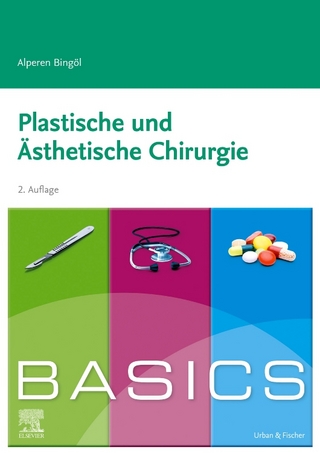
Essential Psychiatry for the Aesthetic Practitioner
Wiley-Blackwell (Verlag)
978-1-119-68012-3 (ISBN)
Assuming no previous background knowledge in psychiatry, the text provides cosmetic practitioners of all training and experience levels with clear guidance, real-world advice, and effective psychological tools to assist their practice. Through common clinical scenarios, readers learn to determine if a patient is a good candidate for a cosmetic procedure, enhance the patient experience, deal with difficult personalities in the cosmetic clinic, recognize obsessive compulsive and body dysmorphic disorders, and more.
Describes how to use psychologically informed approaches and treatments for aesthetic patients
Features easy-to-use psychological tools such as motivational interviewing, progressive muscle relaxation, guided imagery, and acceptance and commitment therapy
Includes extensive references and practical tips for understanding the psychological implications of cosmetic treatments
Covers cosmetic consultations for female, male, and transgender patients
Discusses the history and psychology of beauty as well as the role of cosmetics and cosmeceuticals
Emphasizes the importance of screening for common psychological comorbidities
Addresses the impact of social media on self-image and its role in a growing crisis in beauty and appearance
Highlights the need to develop new guidelines to treat rapidly evolving patient populations
Explores how gender fluidity and variations in ethnicity are changing the approaches to aesthetic patients
Essential Psychiatry for the Aesthetic Practitioner is required reading for dermatologists, plastic surgeons, cosmetic doctors, dentists, nurses, and physician assistants and all other professionals working in aesthetic medicine.
Evan A. Rieder, MD, is a board-certified Dermatologist and Psychiatrist. He is a full-time faculty member of the New York University Department of Dermatology, where he practices cosmetic and medical dermatology, teaches the next generation of physicians, and contributes to the scientific literature and popular media. Richard G. Fried, MD, PhD, is a clinician, researcher, and teacher. He is a board-certified Dermatologist and Clinical Psychologist with numerous publications in professional journals.
List of Contributors xi
Preface xv
Part I The Basics 1
1 Stress, Skin, and Beauty: The Basic Science Base 3
Mary D. Sun and Evan A. Rieder
Basic Science Principles 3
Clinical Correlates 5
Conclusions 9
References 9
2 The Science and Psychology of Beauty 22
Vanessa J. Cutler
Evolutionary Explanations for Beauty 22
Beauty as a Function of Health 23
Weight and Attractiveness 23
Facial Proportions 24
Age and Youth 26
Enhancing Beauty 26
Beauty and the Media 27
Conclusions 28
References 28
3 The Use of Cosmetic Products to Improve Self Esteem & Quality of Life 34
Zoe Diana Draelos
Introduction 34
Human Perceptions of Physical Beauty 34
Topical Cosmetic Products for the Patient with Facial Scarring 36
Cosmetic Camouflage Application 37
Conducting a Cosmetic Product Consultation 39
Conclusions 40
References 40
4 An Approach to Cosmeceuticals 42
Emily C. Milam and Evan A. Rieder
Introduction 42
Case Study 42
Active Ingredients and Indications 44
Approaching the Evidence 44
The Evidence Base is Limited 45
Psychology, Skin Care, and Self-Care 45
Practical Solutions for Patient Consultation 46
Conclusions 46
References 47
Part II Assessment 49
5 Aesthetic Assessment and Theories of Beauty 51
Michael Abrouk, Leslie Harris, Evan A. Rieder, and Jill S. Waibel
Introduction 51
Beauty in our World 52
The Link between Beauty and Mathematics: From Phi to the Golden Triangle 53
Neoclassical Canons and Aesthetics 54
Scales of Aesthetic Assessment 55
How to Approach the Face 57
Case Studies 58
Conclusions 61
References 62
6 The Cosmetic Consultation: Anatomy and Psychology – The Female Patient 64
Eagan Zettlemoyer and Noëlle S. Sherber
Introduction 64
Female Facial Anatomy 64
Structuring the Consult 70
Case Studies 73
Conclusions 75
References 76
7 The Cosmetic Consultation: Anatomy and Psychology – The Male Patient 79
Kalee Shah, Nathaniel Lampley III, and Anthony Rossi
Introduction 79
Male Facial Anatomy 80
Structuring the Consult, Considering Patient Motivations and Psychology 85
Case Studies 87
Conclusions 90
References 91
8 The Cosmetic Consultation: Anatomy and Psychology – The Transgender Patient 94
Brian Ginsberg
Introduction 94
Anatomy 94
Structuring the Consult 95
Setting Expectations 99
Treating Minors 99
Case Studies 99
Conclusions 101
References 101
Part III Perception 105
9 Aesthetic Interventions and the Perception of the Self: Quality of Life and Patient Reported Outcomes 107
Danielle Weitzer and Richard G. Fried
Introduction 107
Perception of Self 108
Perception by Others 109
Outcome Studies 109
Case Study 110
Consequences and Ethical Concerns 112
Conclusions 112
References 113
10 Aesthetic Interventions and the Perception of Others: Observer Reported Outcomes 115
Payal Shah and Evan A. Rieder
Case Studies 115
Observer Reported Outcomes as a Novel Evaluation Tool for Cosmetic Procedures 118
Conclusions 120
References 121
11 Botulinum Toxins: Beauty, Psychology, and Mood in the Cosmetic Patient 125
Catherine Pisano, Jason Reichenberg, and Michelle Magid
Introduction 125
Case Study 125
Pathogenesis 126
Treatment 126
Clinical Relevance and Implications 128
Conclusions 129
References 129
Part IV Psychological Challenges in Aesthetics 131
12 Boundaries 133
Evan A. Rieder and Jacob Sacks
Introduction 133
Case Studies 133
Conclusions 140
References 140
13 Difficult Personalities and Personality Disorders in the Cosmetic Clinic 141
Mio Nakamura and John Koo
Introduction 141
Difficult Personalities vs. Personality Disorders 141
Personality Disorders 142
Case Studies 144
Conclusions 148
References 149
14 Normative Discontent and Social Dysmorphia in the Cosmetic Patient 151
Susruthi Rajanala and Neelam A. Vashi
Introduction 151
Body Image and Body Image Dissatisfaction 151
Social Dysmorphia 152
Case Study 154
Conclusions 154
References 155
15 Obsessive Compulsive Disorder and Body Dysmorphic Disorder in the Cosmetic Patient 157
Mary D. Sun and Evan A. Rieder
Introduction 157
Case Studies 159
Screening for BDD in Aesthetic Medicine 161
Guide to the Clinical Interview for BDD 162
Clinical Approaches to BDD in Aesthetic Medicine 164
Conclusions 164
References 165
16 Protecting Your Patients: When Enough Is Enough – Saying No and Satisfying the Dissatisfied Patient 168
Jacqueline Watchmaker, Prasanthi Kandula, and Michael S. Kaminer
Introduction 168
The LEAP Technique for a Successful Cosmetic Consult 168
Case Study 170
The BLAST Technique for Dealing with Unhappy Patients 170
Case Study 172
Conclusions 173
References 173
17 Protecting Yourself: Legal Issues in Aesthetic Medicine – Informed Consent, Discharge, and Lawsuits 175
Brian P. Hibler and Mathew M. Avram
Introduction 175
Key Legal Terms 175
Case Studies 177
Conclusions 186
References 186
Part V Psychological Tools to Assist Your Practice 189
18 Psychological Tools to Assist Your Practice: Progressive Muscle Relaxation, Deep Abdominal Breathing, Mindfulness, and Guided Imagery 191
Nicholas Brownstone, Bridget Myers, and Josie Howard
Introduction 191
Case Studies 191
Conclusions 196
References 197
19 Hypnotic Techniques for the Aesthetic Practitioner 200
Philip D. Shenefelt
Introduction 200
Informal Hypnotic Techniques 200
Hypnotizability 201
Formal Hypnotic Techniques 201
Case Studies 202
For Additional Information 204
Conclusions 204
References 205
20 Acceptance and Commitment Therapy in the Aesthetic Setting 206
Vanessa J. Cutler
Introduction 206
Understanding Acceptance and Commitment Therapy 206
Incorporating ACT into an Esthetics Practice 208
Case Study 211
Special Populations to Note 212
Conclusions 212
References 213
21 Behavioral Modification for Acne Excoriée and Skin Picking 216
Karen M. Ong, Mary D. Sun, and Evan A. Rieder
Introduction 216
Case Study 216
Behavioral Modification 219
Conclusions 220
References 221
22 Motivational Interviewing for Identification and Triage of the Cosmetic Addict 223
Richard G. Fried and Evan A. Rieder
Introduction 223
Case Study 223
Using Elements of Motivational Interviewing to Identify and Redirect Inappropriate Cosmetic Patients 225
What Is Motivational Interviewing? 225
Specific Techniques 225
Exploration 227
Change Talk 228
Reflection 228
Breaking Barriers 228
Committing to Change 229
Conclusions 229
References 229
23 Beauty Through the Life Continuum 230
Doris Day
Introduction 230
Communication 230
Trust 231
Case Study 233
Developing a Long-Term Healthy Relationship with Beauty 234
Conclusions 235
References 236
Index 237
| Erscheinungsdatum | 15.01.2021 |
|---|---|
| Verlagsort | Hoboken |
| Sprache | englisch |
| Maße | 183 x 257 mm |
| Gewicht | 726 g |
| Themenwelt | Medizin / Pharmazie ► Allgemeines / Lexika |
| Medizinische Fachgebiete ► Chirurgie ► Ästhetische und Plastische Chirurgie | |
| ISBN-10 | 1-119-68012-3 / 1119680123 |
| ISBN-13 | 978-1-119-68012-3 / 9781119680123 |
| Zustand | Neuware |
| Informationen gemäß Produktsicherheitsverordnung (GPSR) | |
| Haben Sie eine Frage zum Produkt? |
aus dem Bereich


